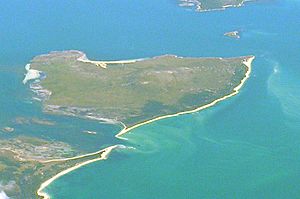Vansittart Island facts for kids
Vansittart Island, also known as Gun Carriage Island, is a large island made of granite. It covers about 800 hectares (which is like 2,000 acres). This island is part of the Vansittart Island Group in Tasmania, Australia. It sits in the eastern Bass Strait, between Flinders and Cape Barren Islands.
Some parts of the island are privately owned, and other parts are leased land. Farmers use it to raise Wiltshire Horn sheep. Vansittart Island is also very important for birds! It's part of the Franklin Sound Islands Important Bird Area. This means it's a special place where more than 1% of the world's population of six different bird species live.
Contents
A Look Back: History of the Island
Early Settlers and Changes
Long ago, in the 1820s, people who used to hunt seals in the Bass Strait lived on Vansittart Island. In 1831, a man named George Augustus Robinson came to the island. He wanted the sealers and their families to leave. His plan was to create a settlement for Aboriginal people there.
However, the Aboriginal settlement didn't work out. So, the sealers and their families came back to the island. By 1854, when Bishop Nixon visited, their community had grown to 28 people.
How the Island Got Its Name
In 1842, a famous ship called HMS Beagle officially mapped the island. They changed its name from Gun Carriage Island to Vansittart Island. The name "Vansittart" is important in sea history. It comes from Henry Vansittart, who was a governor in India a long time ago (from 1759 to 1764).
The HMS Beagle had just sailed around Australia. It then joined another ship, the Vansittart, to map the northeast coast of Tasmania and the Bass Strait. That's when "Gun Carriage Island" was officially renamed "Vansittart Island."
The vessel Vansittart was originally a private ship. It arrived in Hobart Town, Tasmania, in 1836. Just a few days later, the HMS Beagle also arrived in the same harbor. On board the Beagle were Captain Robert Fitzroy and Charles Darwin, who was working on his famous Theory of Evolution. This was one of two important times these two ships met. The Vansittart was later bought by the government of Van Diemen's Land (which is now Tasmania) in 1837 to help with "search and rescue" missions.
The Vansittart ship often visited Port Arthur. It became a government ship that collected money and was also used for transport. It is believed to have carried the last Aboriginal people from the main island of Van Diemen's Land to the Flinders Group for a resettlement plan that didn't succeed. The Vansittart was lost at sea in 1849 while sailing to California.
Animals and Plants on the Island
Island Vegetation
Sadly, most of the original plants and trees on Vansittart Island have been removed. This happened because of fires and large machines called bulldozers with chains. This destroyed many groups of Oyster Bay pine trees.
Wildlife on Vansittart Island
Many interesting birds live and have their babies on the island. These include the little penguin, Pacific gull, sooty oystercatcher, and pied oystercatcher. Black swans have also built nests here. The island is also a safe place for Cape Barren geese.
You can find several types of reptiles on the island. These include the tiger snake, copperhead snake, white-lipped grass snake, southern grass skink, metallic skink, and Bougainville's skink. Echidnas also live there. However, the Tasmanian pademelon, a small marsupial, no longer lives on the island.


